|
Galvin
Manufacturing Company (Motorola) in World War Two
Chicago, IL
1928-Current
This page updated 7-6-2025.
Motorola has been a part of my life for most
of my years. Not long after I was born, my parents bought a
Motorola table mount black and white television that stood in the corner
of the living room. It was on that TV that I watched everything
from Howdy Dowdy, Saturday morning cartoons, the Lone Ranger to the Ed
Sullivan Show. When I was an electrical engineering student in the
late 1960s and early 1970s, Motorola was one of the leading high-tech
companies in the country. It was a highly desirable place for EEs to work after
graduation. After I got married, and our current TV was no longer
operating satisfactorily, we purchased a Quasar 25-inch color TV from a
local "mom and pop" appliance store. This was long before the days of the big
box stores. I remember my wife and I driving down to the store,
picking out the television off the display floor, loading it into the
back of our pickup truck, and taking it home. Quasar was a
Motorola television brand introduced in 1967. I was unaware until
researching this page that Motorola sold the
Quasar operation to Panasonic in 1974. All these years I thought I had
purchased a Motorola built TV. Then in 2004, Motorola came out with
the Razr cell phone. It was so small and good looking compared to
the current cell phone I was using. When I tried to purchase one
from my cell phone provider, they were sold out. I had to go back
the next day to get mine. Even after Motorola stopped producing
them, and my cell phone provider stopped selling them, I continued on
with my Razr. It was only when my cell phone provider informed me
a few years ago that the phone would no longer work on the new network
that was coming out, that I gave up my trusted Razr.
While visiting the UDT-Seal Museum in July
2019, I noticed a World War Two handie talkie. I had seen several
of these over the past couple of years in my research of World War Two
products, and had not paid too much attention to them, because usually
the data plate with the manufacturer's name on them were missing.
However, this one had the data plate on it, and it said Galvin
Manufacturing Company. Galvin changed its name to Motorola in
1947. Motorola, via Galvin Manufacturing Company, had come back
into my life.

The Motorola handie talkie at the UDT-Seal
Museum in Fort Pierce, FL. I have visited this museum several
times over the years while vacationing in Florida, the most recent
being two years prior. I don't remember this radio being on
display at the time. I noticed that several other items in the
World War Two display section had changes since my last visit.
Author's photo.
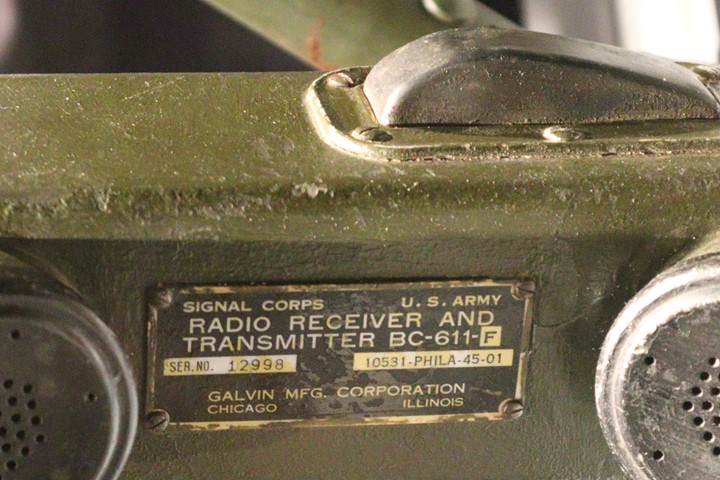
The data plate shows that the unit was built
by the Galvin Manufacturing Company, with serial number 12998. The
10531 I believe is the Signal Corps contract number dated 1945. The BC-611-F Radio Receiver and Transmitter make up the SCR-536 radio
set. The technical manual for the SCR-536 shows that the "F"
version was the final modification of the radio produced. Author's
photo.
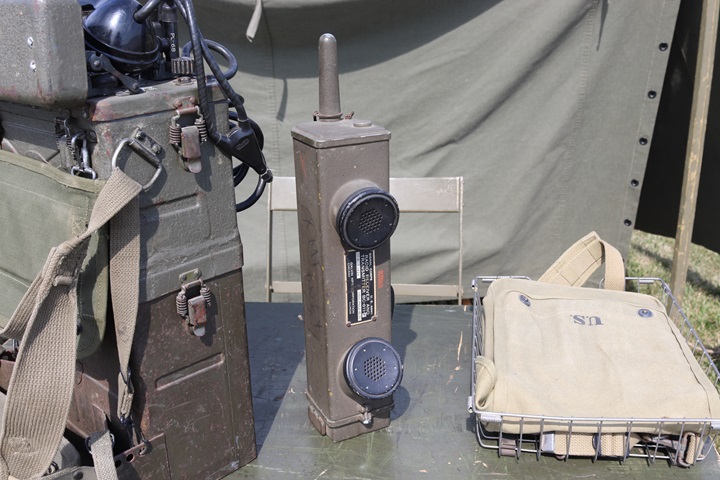
Two weeks after visiting the UDT Museum, I
was at the Greenwood, IN annual airport open house with some family and
two granddaughters. Along with aircraft and military vehicles on
display were re-enactors, one with radios. He had this Galvin
manufactured SCR-536 on display next to a SCR-300 walkie talkie.
Author's photo.
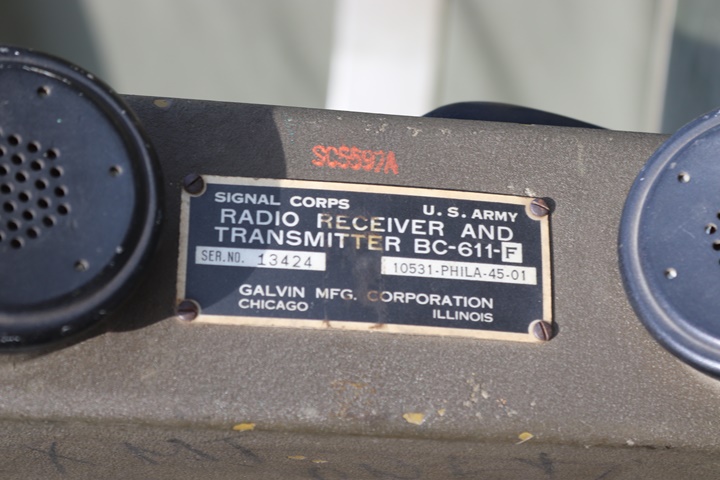
This one was serial number 13424 with the
same contract number and date as the one at the UDT Museum.
Author's photo.
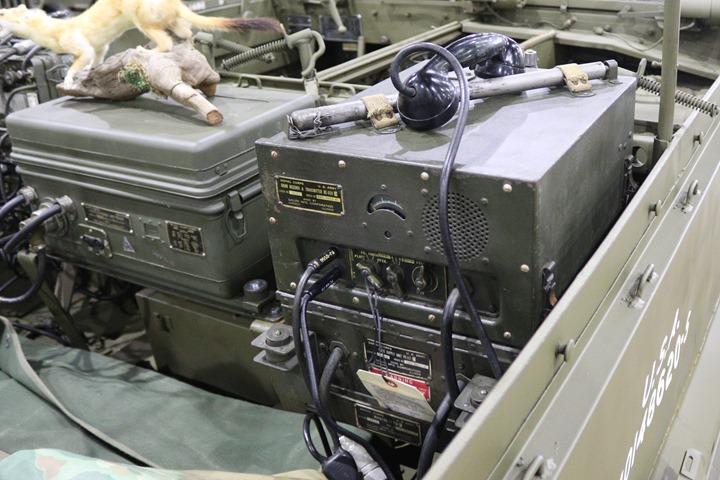
A week after the Greenwood event, I was at
the national MVPA convention in York, PA. There I found this
BC-659 Radio Receiver and Transmitter built by Galvin Manufacturing.
It has serial
number 8507. The company,
I realized, built more than handie talkies during World War Two.
The BC-659 was used by the field artillery during the war.
Author's photo.
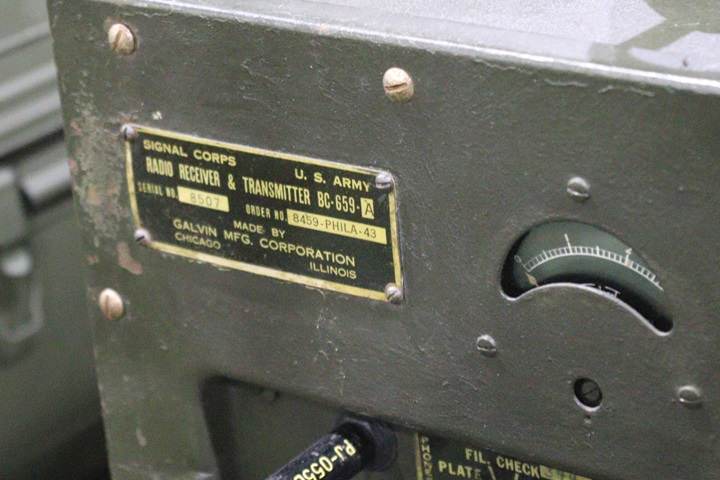
Author's photo.
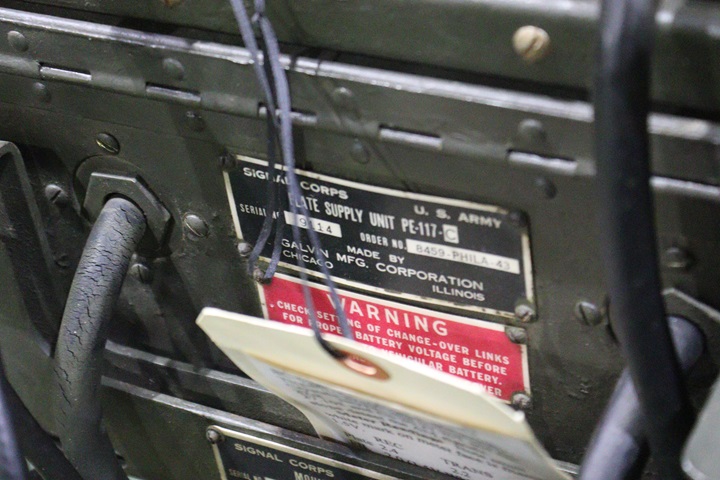
Galvin also manufactured the PE-117 Plate
Supply Units for the BC-659 radios. This one is serial number 9114
with a 1943 Signal Corps Contract. Author's photo.
It was becoming obvious to me that Galvin
Manufacturing Company had played an important role in providing radio
equipment during World War Two, and that maybe I should do a special
page on it for this website.
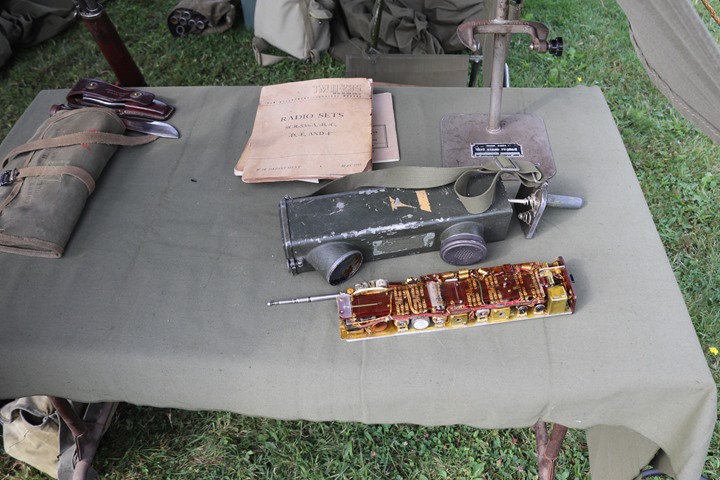
A week after the MVPA convention, I was at
D-Day Conneaut 75 in Conneaut, OH. (Yes, July and August 2019 were
very busy months for me!) As I was getting ready to leave for home, I made one last walk through the huge American re-enactor camp. Walking down a row I had missed before, I came
upon this display. On the table was an SCR-536 radio.
It was at this point that this page on the Galvin Manufacturing Company
(Motorola) came into being. Author's photo.
We will return to this radio down later in the
page, but first the basics on the Galvin Manufacturing Company.

Galvin Manufacturing Company won the
Army-Navy "E" Award five times during World War Two.
-
1928 - Paul and Joseph
Galvin incorporated Galvin Manufacturing Company in Chicago, IL,
with the purchase of the bankrupt Stewart Storage Battery Company.
-
1930 - Galvin introduces
the Motorola car radio. The term "Motorola" was a combination
of "motor" for its use in automobiles, and "ola" which represented
sound. It was company co-founder Paul V. Galvin that came up
with the term that met "sound in motion."
-
1939 - Galvin
Manufacturing introduces its first two-way radio. This was the
T69-20 AM police car radio transmitter and receiver.
-
1937 - Galvin introduced
home radios and record players.
-
1940 - Galvin developed
the SCR-536 AM portable, two-way radio for the U.S. military.
-
1940 - Galvin developed
the SCR- 300 FM "Walkie-Talkie," two-way radio for the U.S.
military.
-
1941 - Galvin introduced
the Playboy personal radio with the antenna concealed in the front
cover.
-
1941 - Galvin developed
the SCR-511 for the U.S. Army horse cavalry.
-
1942 - The company
received its first of five Army-Navy "E" Awards.
-
1942 - Galvin developed
and produced the SCR-509 two-way, FM vehicle radio for the U.S.
military.
-
1942 - Galvin developed
and produced the SCR-510 two-way, FM vehicle radio for the U.S.
military.
-
1942 - Galvin developed
and produced the SCR-609 two-way, FM vehicle radio for the U.S.
military.
-
1942 - Galvin developed
and produced the SCR-610 two-way, FM vehicle radio for the U.S.
military.
-
1947 - Galvin
Manufacturing became Motorola, Inc.
-
1947 - Motorola began
producing televisions.
-
1960 - Motorola
introduced the "Astronaut" 19-inch television. This was the
world's first cordless, portable TV.
-
1952 - The Motorola
Semiconductor division started production of semiconductors with a
3-amp power transistor.
-
1956 - Motorola was the
first to introduce fully transistorized car radios.
-
1960 - Motorola
introduced the Mesa silicon transistor, the smallest at the time.
-
1962 - John Glenn's
space capsule "Friendship 7" communicated with ground control with a
Motorola radio.
-
1967 - The Motorola
Quasar television had the "works in a drawer" for easy servicing.
-
1973 - Motorola
demonstrated the first portable cellular telephone and system.
-
1977 - Voyager 1
transmitted photos back to earth from a billion miles away with a
Motorola radio. Voyager 2 also had Motorola radios.
-
2004 - Razr cell phone
introduced.
-
2011 - Motorola is split
into two companies: Motorola Solutions has the product lines
of police products, radios and commercial application.
Motorola Mobility has on the cell phone products.
Galvin Manufacturing World War Two Military
Products:
|
Galvin
Manufacturing Company World War Two Radio Production
Source:
ttp://www.prc68.com/MCGP/MCGP98/MRC8-20.TXT |
|
Radio Designation |
Radio Type |
Number built by Galvin |
Other contractors |
Number built by other contractors |
Total number built |
Comments |
|
SCR-536 (BC-611) |
AM
Portable "Handie Talkie" |
137,031 |
Electrical
Research Laboratories, Evanston, IL |
4,500 |
141,531 |
Galvin design.
96.8% of all SCR-536s were built by Galvin. |
|
SCR-300 (BC-1000) |
FM
Portable "Walkie Talkie" |
46,911 |
Philco Radio Corporation |
8,000 |
54,911 |
Galvin design.
85.4% of all SCR-600s were built by Galvin. |
|
SCR-509, 510 (BC-620) |
SCR-509 FM Ground Transportable Armored Forces Radio
SCR-510 FM Armored Forces Vehicle
Mounted Radio |
34,127 |
Continental Radio and Television (Admiral after the war) |
7,710 |
41,837 |
Signal Corps design
with Galvin doing final development for manufacturability.
81.5% of all SCR-509s and 510s were built by Galvin.
|
|
SCR-609, 610 (BC-659) |
SCR-609 FM Ground Transportable Field Artillery Radio
SCR-610 FM Field Artillery
Vehicle Mounted Radio |
62,496 |
Continental Radio and Television and Belmont Radio Corporation |
13,899 |
76,395 |
Signal Corps design
with Galvin doing final development for manufacturability.
81.8% of all SCR-609s and 610s were built by Galvin.
|
|
Total Radios Built |
|
280,565 |
|
34,109 |
324,674 |
|
| |
|
|
|
|
|
|
|
Other |
|
|
|
|
|
|
| PE-97
|
Plate
Supply for SCR-509, 510 |
? |
|
7,710 |
|
It is unknown how
many were contracted out to other suppliers. |
|
PE-117 |
Plate
Supply for SCR-609, 610 |
At least 9,114
based on serial number for PE-117 shown above. |
|
13,899 |
|
It is unknown how
many were contracted out to other suppliers. |
|
Total Plate Supplies Built |
|
At least 9,114 |
|
21,609 |
|
|
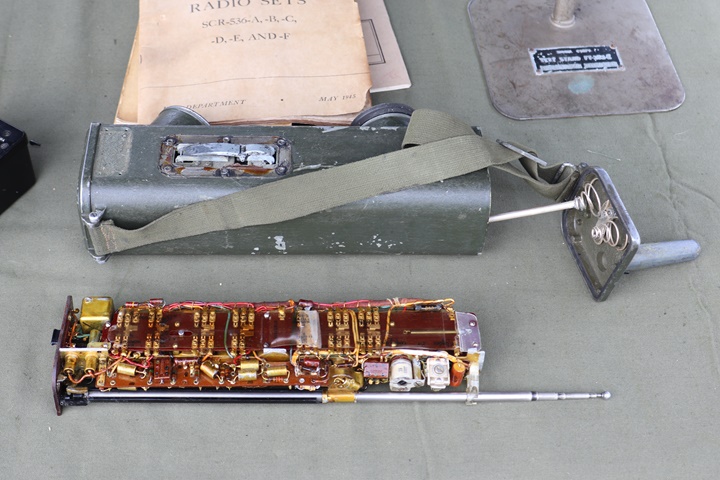
As shown above, Galvin produced 137,031 of
the handie-talkie radio units like the one above. This is a very
compact and well-engineered unit, considering that in 1940 most radios
used point-to-point wiring. Circuit boards were a thing of the future.
Author's photo.
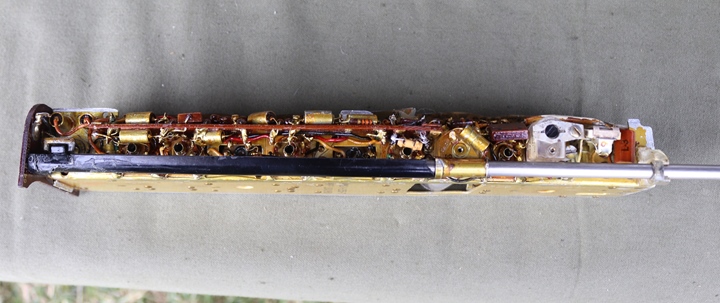
There was no volume or squelch control on
the radio. There was also no on-off switch. To turn the unit
on, the operator pulled out the antenna. In this photo, the radio
is in the off position. The next photo shows a close-up of the
lower left-hand corner of the unit. Author's photo.
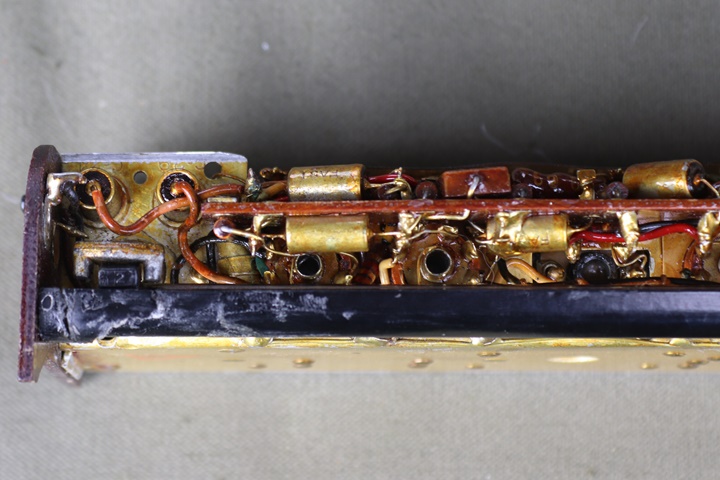
Note in the lower left hand-corner, there is
a metallic die cast or powdered metal U-shaped piece. The unit is
in the off position. Author's photo.
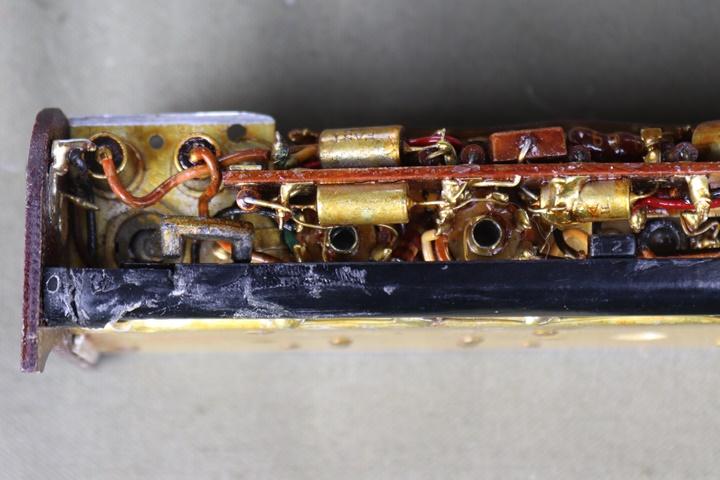
Note the position of the U-shaped piece now. I have pulled the
antenna out, and the
radio is now turned on. Author's photo.
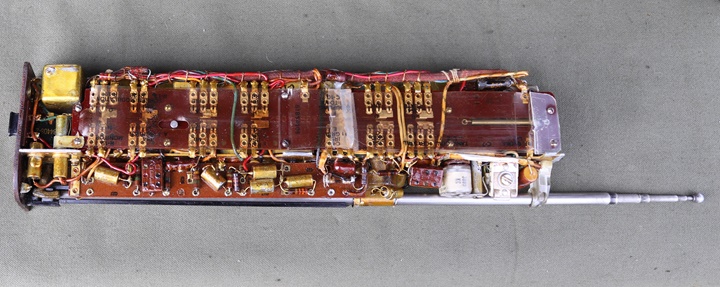
The SCR-536 was a true transceiver, in that
the tubes were used both for receiving and transmitting. This
was done by a unique engineering design of the radio. In this
orientation, the radio has a clear plastic covering that runs most of
the length of the unit. Underneath the plastic are six sets of
electrical contacts in groups of three and two. Underneath the
contacts is an insulating board that has a spring attached to it at
the right end of the unit. At the left end, just to the right of
the second set of contacts, is a small round metal button. This is
attached to the insulating board with the spring attached to it. Author's photo.
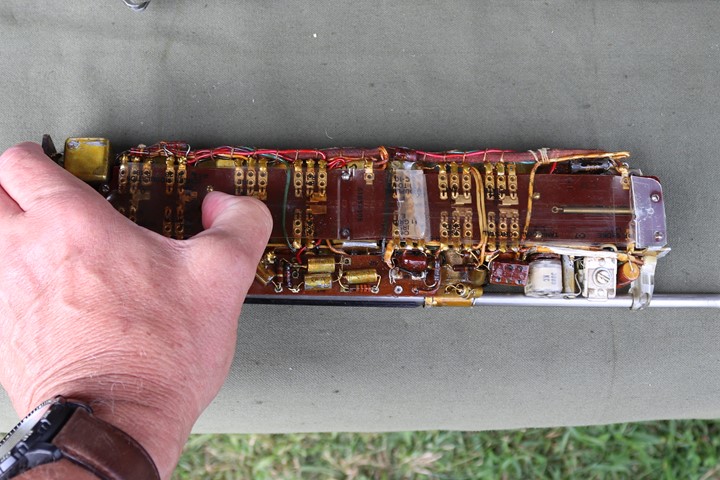
My thumb nail is on the small little round
button. Note that underneath the sets of three and two contacts
there are copper contacts attached to the insulating board with the
spring. These contacts are under the right two contacts above
them. The unit is in the receive position. Author's photo.
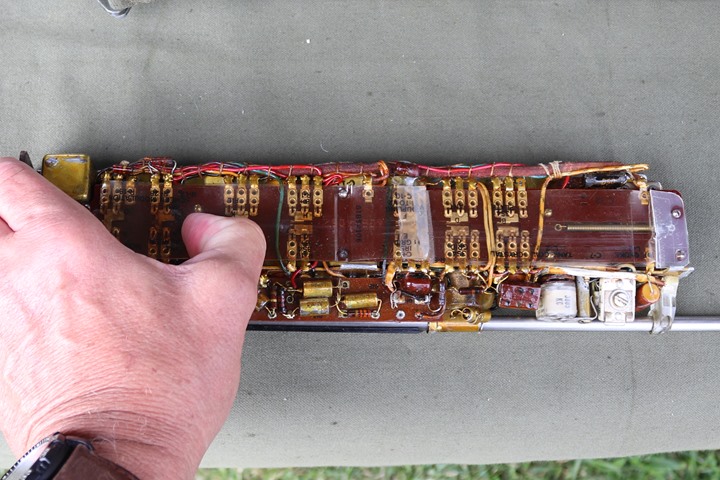
I have now moved the metal button to the left. The contacts on the
insulating board with the spring have also moved to the left and are now
under the left two contacts above them. This puts the radio in the
transmit mode. They are really not all the way over, as I did not
put enough lateral force on the little metal button to move them the
entire distance. The person at the tent told me that the operator
of the radio had to push down really hard on the transmit button to put
it in that mode. Author's photo.
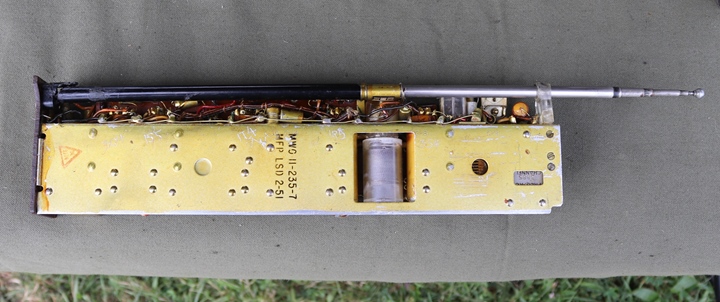
Author's photo.
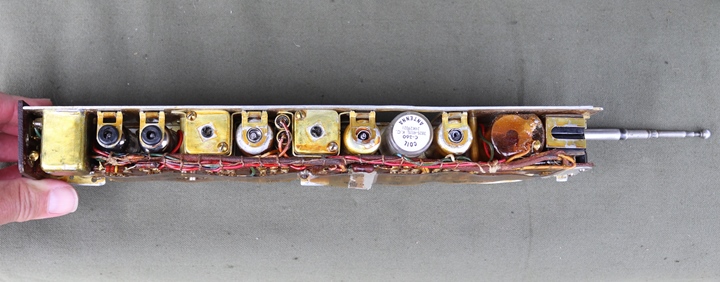
This orientation shows the tops of the five glass tubes. Author's photo.
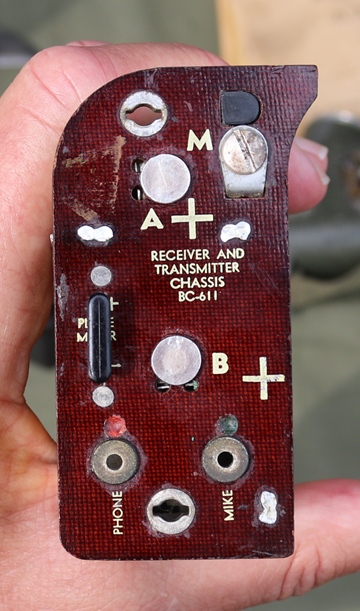
This shows the bottom insulating board. This is an 'F" model of
the BC-611 which added the phone and microphone jacks. Author's photo.
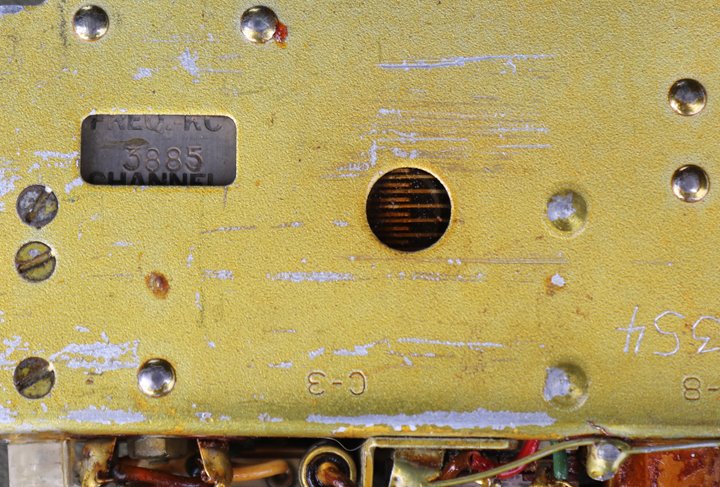
The radio operated over 3.5 to 6.0 megahertz on 50 different channels.
The radio is crystal controlled, and in this unit, there is a 3.885
megahertz crystal installed. In changing frequencies, tank coils
also needed to be changed, and this was all done by a radio technician.
The 1.5 volt filament and 103.5 volt plate batteries had a life of 19
hours of operation. Total weight of the radio with batteries was
5.5 lbs. Range was one mile over land. Author's photo.
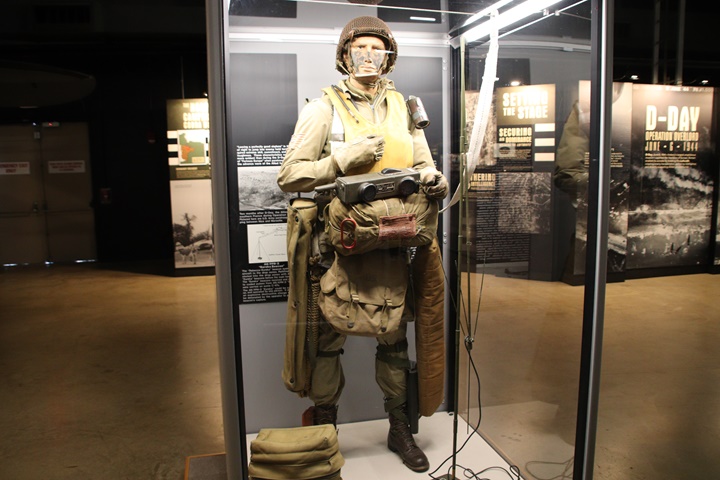
I visit the Museum of the United States Air
Force on a regular basis. I have walked by this Normandy
paratrooper many times without realizing there was a walkie-talkie as
part of the display. This was my second visit to the museum since
I originally published this page on Galvin Manufacturing. Author's
photo added 10-23-2019.
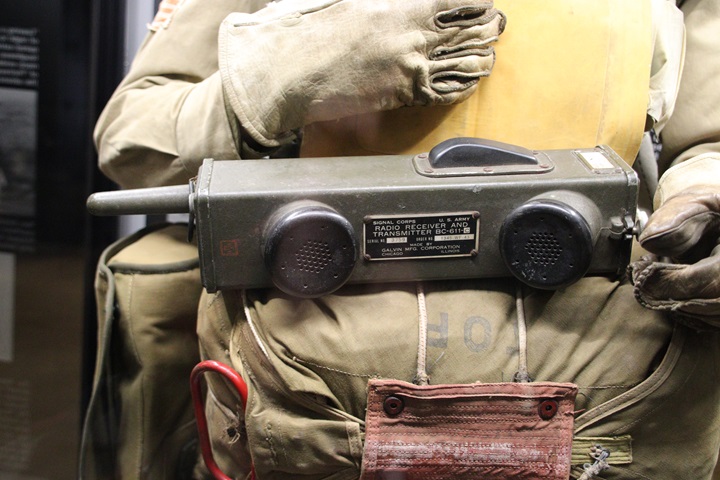
Author's photo added 10-23-2019.
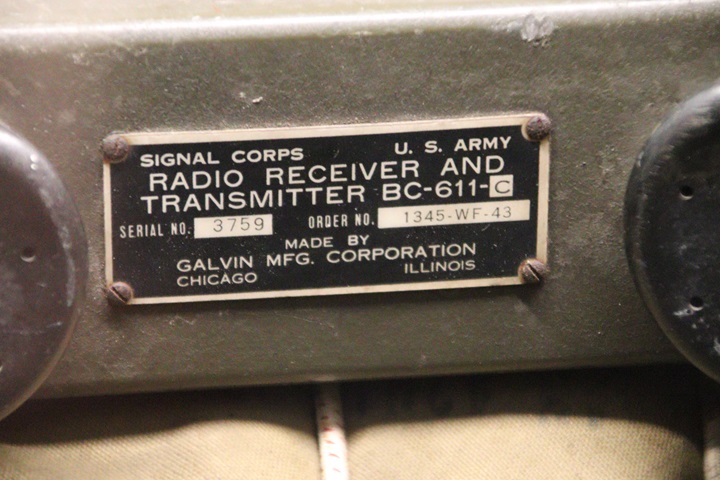
This particular example is a BC-611-C model
which is a part of a 1943 order. It is serial number 3759 in order
number 1345-WF-43. Author's photo added 10-23-2019.
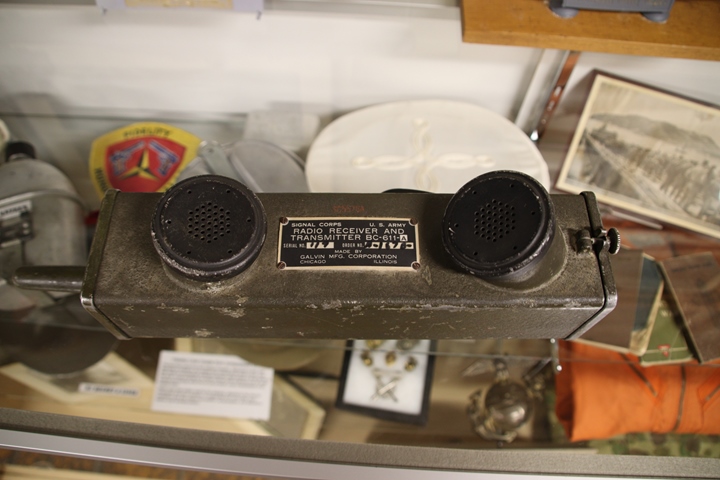
This BC-611-A is on display at the Central
Ohio Military Museum in Harrisburg, OH. Author's photo added 10-6-2020.
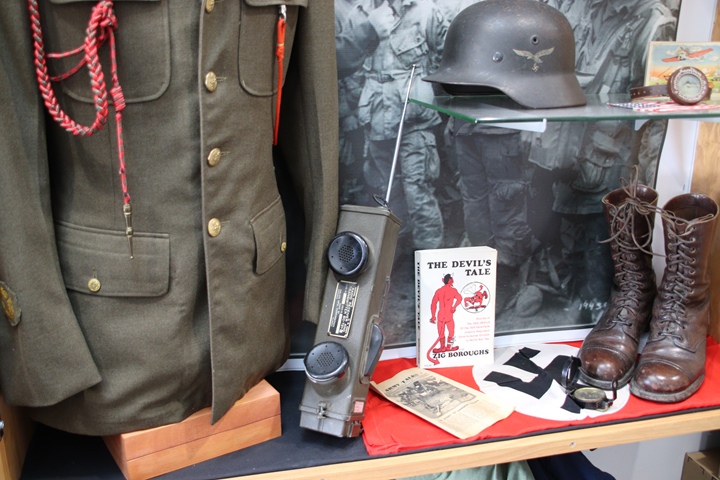
This is a BC-721 which is the glider version
of the BC-611. The radio has an extra section at the bottom which
contains multi-conductor plug for microphone, headphones and external
power. This gave the troops in the glider some limited radio
communication during flight. This one is on display at the
Michigan Military Historical Museum in Grass Lake, MI. Author's
photo added 2-2-2021.
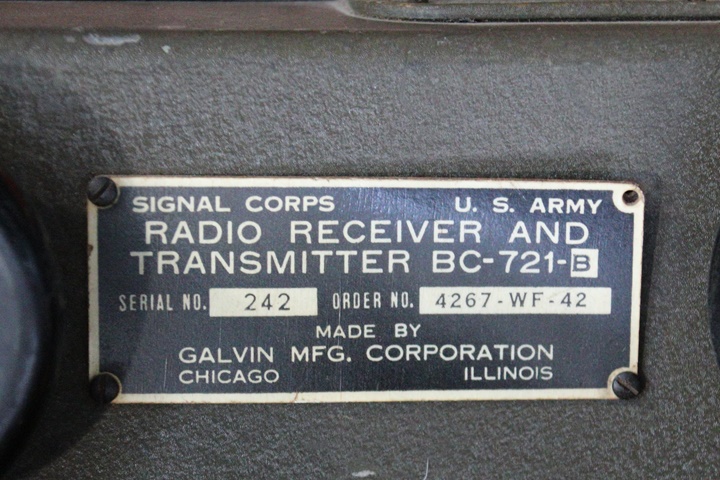
It is serial number 242. Author's
photo added 2-2-2021.
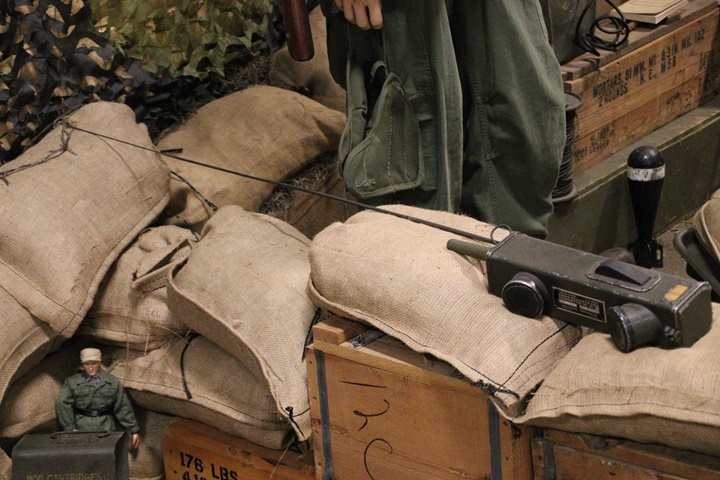
This Galvin-built BC-611-F is on display at
the Michigan Technological & Historical Society in Eastpointe, MI and
shows the antenna fully extended. Author's photo added 4-20-2021.
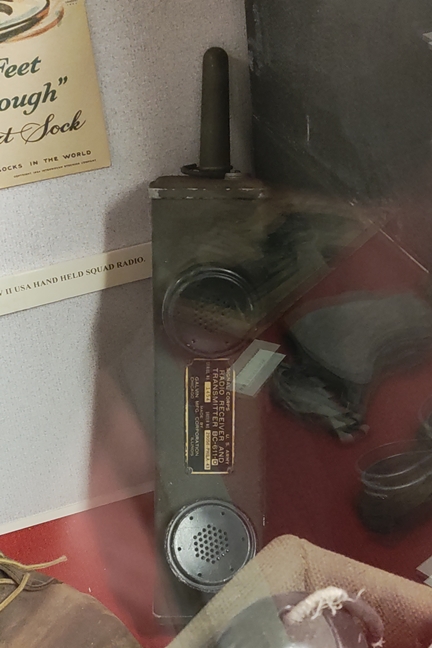
This Galvin Manufacturing-built BC-611-D is
on display in the World War Two section of the Indiana War Museum in
downtown Indianapolis, IN. Author's photo added 7-6-2025.
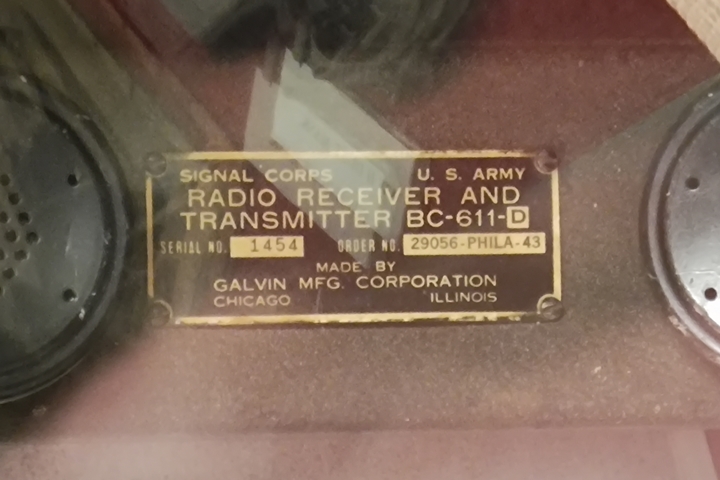
This unit is serial number 1454.
Author's photo added 7-6-2025.
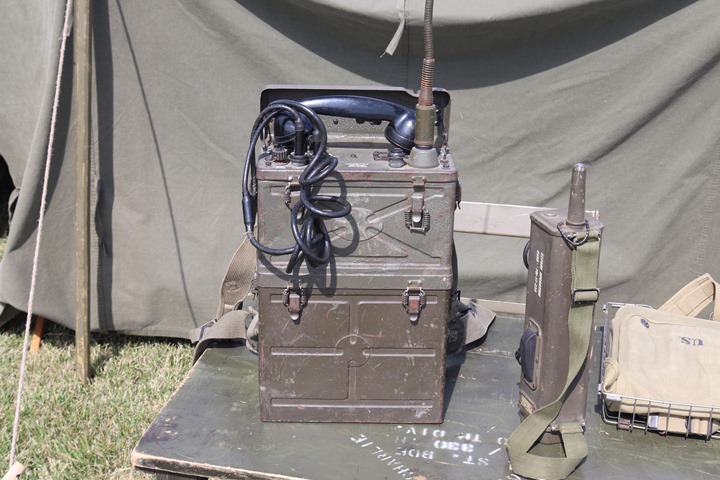
This SCR-300 with BC-1000 was on display next the SCR-536 at the
Greenwood, IN airport 2019 open house. This was the walkie talkie
as both the radioman and the officer using the headset with long cord
could walk while the radio was in use. This shows the two units,
the BC-1000 radio on top and the battery back below. Author's photo.
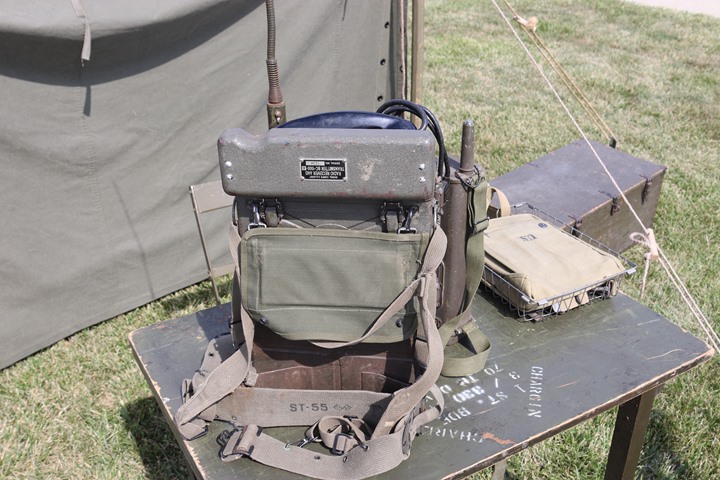
First use of the walkie talkie was during the invasion of Italy in 1943.
This photo shows the padding and straps, allowing the radio
operator to wear it on his back. The total weight with the
battery back was 38 pounds. Author's photo.
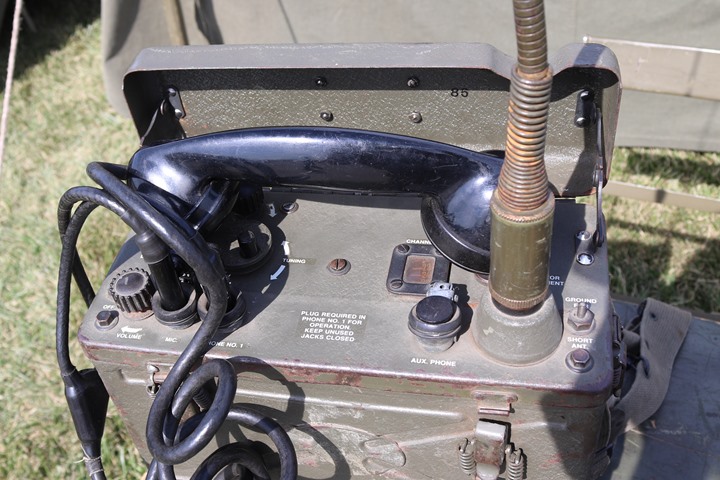
The FM radio operated on 41 channels from 40 to 48 megahertz and had a
range of three miles. Author's photo.

There is no manufacturers ID on the data plate. From the table
above, there is an 85% probability it is a Galvin. Otherwise, it
was built by Philco Radio. Author's photo.
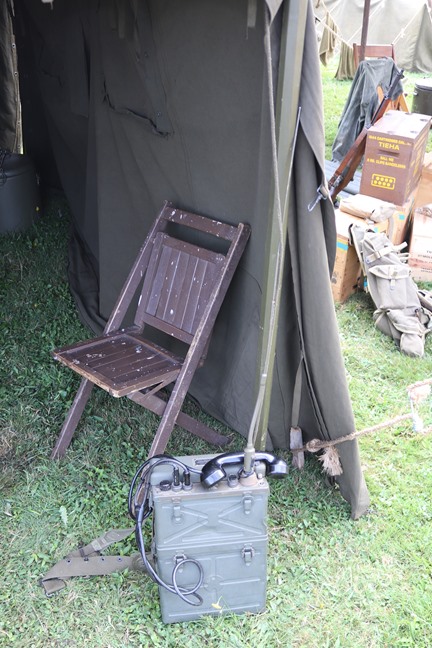
This SCR-300/BC-1000 was found at the 2019 Conneaut D-Day 75 Reenactment
in Ohio. Author's photo.
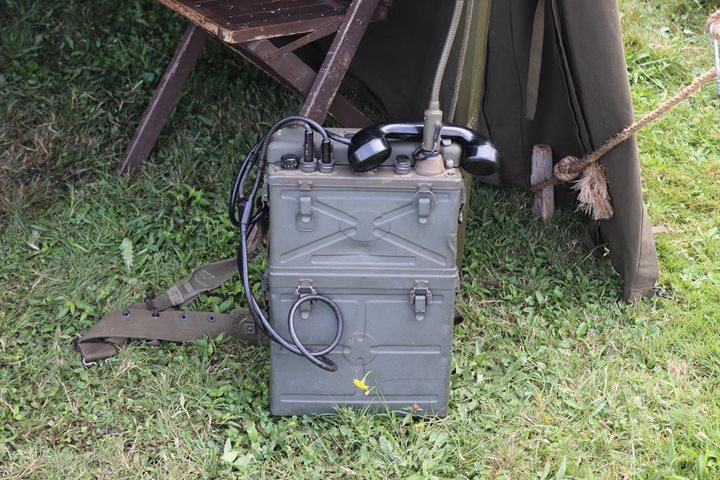
Author's photo.
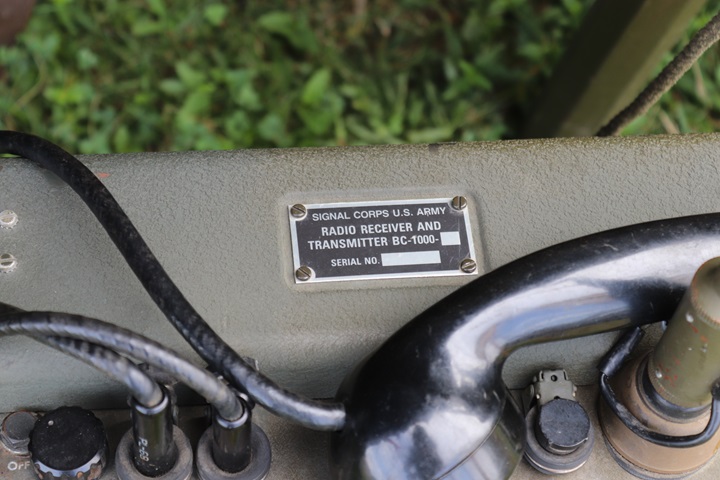
The original data plate has been lost; and
this is a modern reproduction. Author's photo.
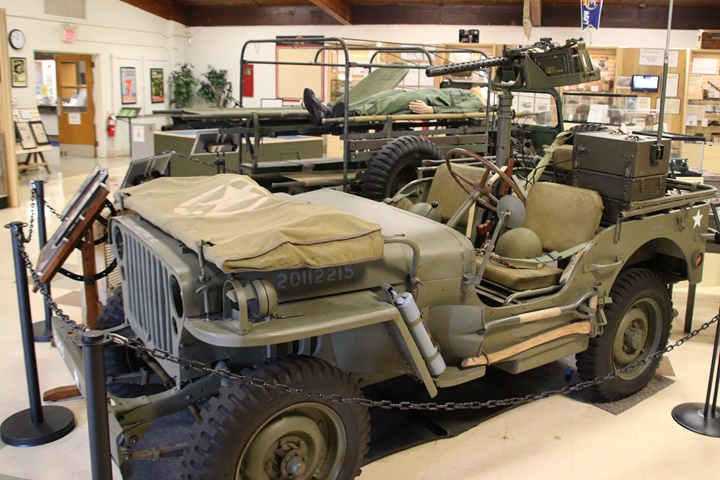
This Ford GPW is on display at the Michigan
Technological & Historical Society in Eastpointe, MI, and has a Galvin
BC-659 radio set in it. Author's photo added 4-20-2021.
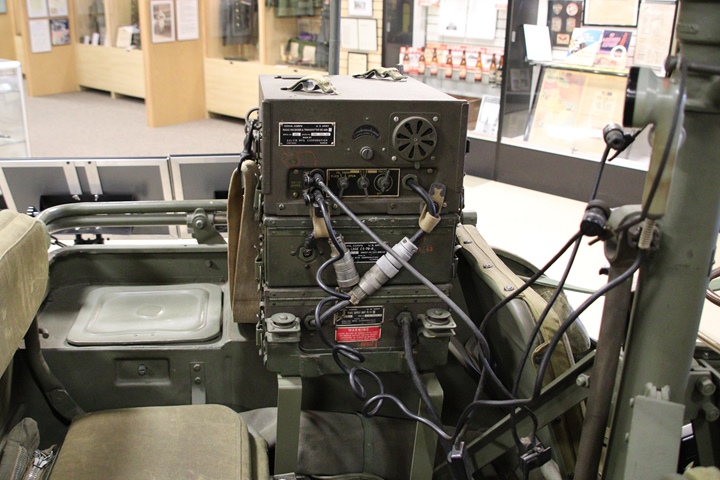
Author's photo added 4-20-2021.
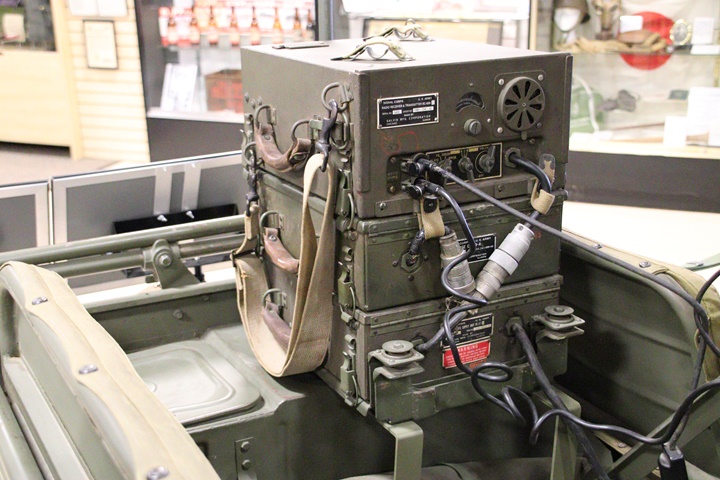
The BC-659 is the top device and is serial
number 5432. The middle box is Case CS-79-A serial number 1717.
The bottom box is Plate Supply PE-97-A serial number 13562. All
were built by Galvin Manufacturing. Author's photo added
4-20-2021.
Electrical Research Laboratories SCR-536:
This company built 4,500 of the handie-talkies under license from Galvin
during World War Two. This was only 3.2% for the total units
built, so finding one today is a more challenging than finding a
Galvin-built one.
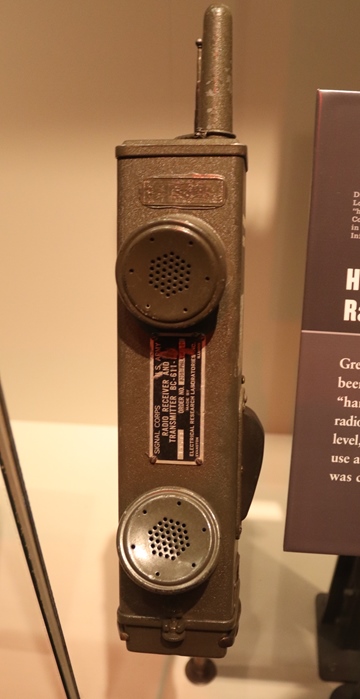
This example is on display at the National
Infantry Museum at Fort Benning, GA. Author's photo added May 5,
2020.
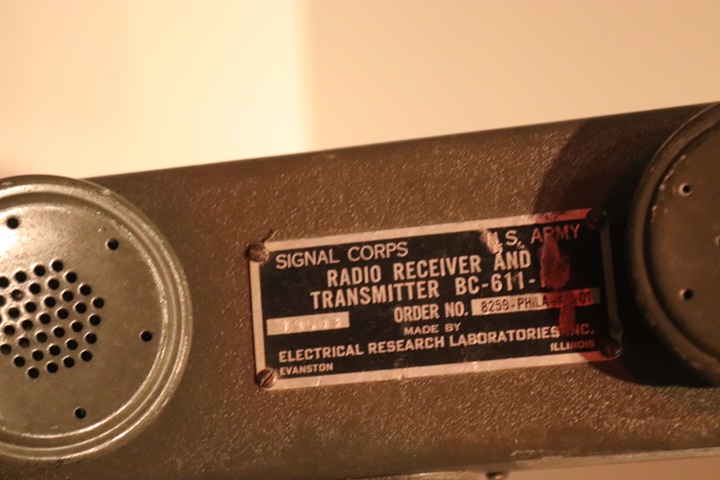
This is serial number 19509. Author's
photo added May 5, 2020.

This Electrical Research Laboratories
SCR-536 was part of a World War Two re-enactors display. The radio
appears to have been re-built. Author's photo added 10-6-2020.
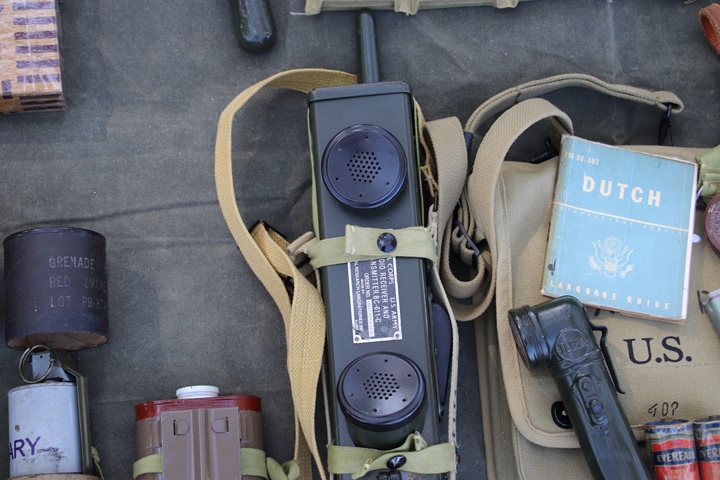
Author's photo added 10-6-2020.
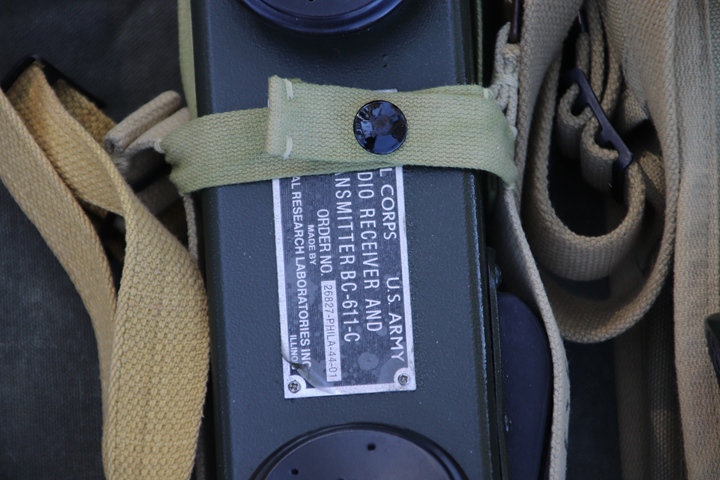
The serial number was covered up. In
retrospect, I should have asked to have had the re-enactors uncover it
for me. Author's photo added 10-6-2020.
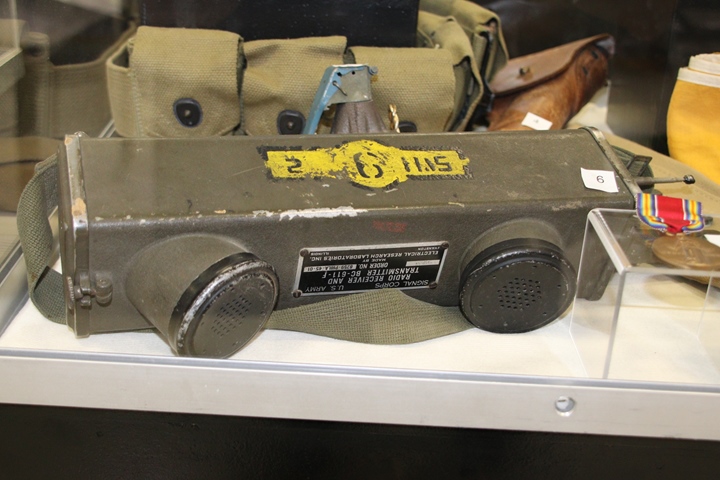
Electrical Research Laboratories SCR-536 is
on display at the Yankee Air Museum in Bellevue, MI. Author's
photo added 4-20-2021.
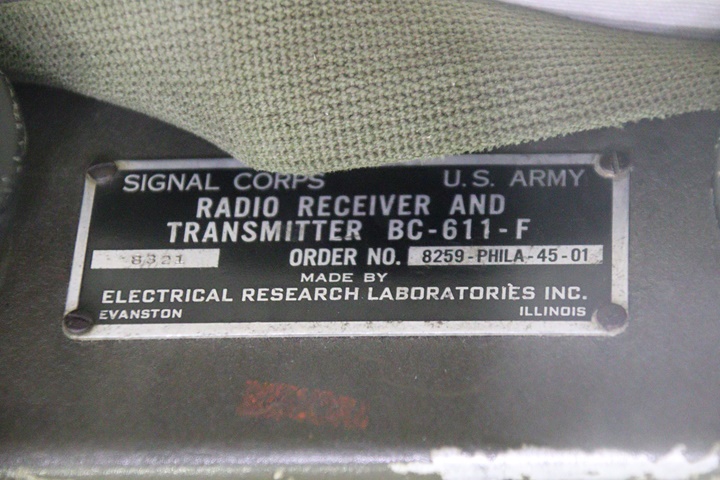
It is serial number 8321.
Author's photo added 4-20-2021.
|













































